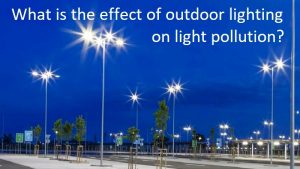How can we reduce light pollution?
There are several ways in which we can reduce light pollution:
- Use outdoor lighting fixtures that are designed to direct light downward, rather than allowing it to scatter in all directions. This can help reduce the amount of light that is wasted and dispersed into the sky.
- Choose outdoor lighting fixtures with warm colors of light, such as amber or orange, rather than blue or white light, which can be more disruptive to human health and the environment.
- Install motion sensors or timers on outdoor lighting fixtures to ensure that they are only in use when they are needed.
- Use shields or hoods on outdoor lighting fixtures to prevent light from being directed upwards or sideways.
- Use lower wattage bulbs in outdoor lighting fixtures, which can help reduce the amount of light that is emitted and save energy.
- Encourage local governments and municipalities to enact and enforce light pollution ordinances and regulations.
- Educate individuals and communities about the importance of reducing light pollution and the negative impacts it can have on the environment, wildlife, and human health.
By implementing these strategies, we can all play a role in reducing light pollution and promoting a more sustainable and healthy world.
Another effective way to reduce light pollution is to promote the use of dark-sky friendly lighting. This type of lighting is designed to minimize light pollution by directing light downward and using shields or hoods to prevent light from being directed upward or outward. Dark-sky friendly lighting is typically characterized by a warm color temperature, which is less disruptive to wildlife and human health.
Additionally, the use of LED lighting technology can also help reduce light pollution. LEDs are more energy-efficient than traditional lighting technologies, such as incandescent or fluorescent bulbs, and they can be designed to emit light in specific wavelengths that are less disruptive to the environment and wildlife. However, it is important to note that not all LED lighting is created equal, and some types of LED lighting can actually be more harmful to the environment and human health than traditional lighting technologies.
Another way to reduce light pollution is to establish and maintain designated dark-sky areas, such as national parks or wildlife reserves. These areas are typically located in remote, rural areas that are far from sources of artificial light pollution, and they are managed to ensure that they remain free from light pollution.
Finally, it is important to recognize that reducing light pollution is not just about preserving the night sky; it is also about promoting human health and well-being. Exposure to artificial light at night has been linked to a range of negative health outcomes, including disrupted sleep patterns, increased risk of obesity and depression, and disruptions to the body’s natural circadian rhythms. By reducing light pollution, we can create a healthier and more sustainable world for ourselves and future generations.





